https://www.zerohedge.com/markets/protecting-your-capital-during-war
Authored by ‘Fritz’ via Asia Stock Report,
Wars are one of the greatest destroyers of capital.
In Barton Bigg’s book “Wealth, War & Wisdom”, he makes the case that to protect your capital during a war, investors need to own diversified portfolios of stocks and property in safe regions. The book chronicles the experience of investors during World War II: whose wealth was destroyed and why. And what you could have done to protect your wealth.

Biggs comes to the conclusion that the following asset classes were best at preserving wealth, ranked from best to worst:
1. Survival goods
Prices for daily necessities shot up during the war. And so, the people who got rich were often the black marketers. The black market was the most lucrative profession and the best source of wealth as the war raged on. Stocks, land, real estate and businesses on the other hand, worked only if you had a very long-term horizon.
What black marketers did was hoarding survival goods such as clothing and food and then selling them at high prices to desperate fellow citizens. Then using their black money to buy and hoard gold.
In Japan, people became increasingly desperate as the war progressed. Becoming cold and hungry, paying up for clothes, food and whatever other survival goods they could get their hands on. Even selling land at fire-sale prices in order to survive. Biggs tells stories of people involved in the sourcing of black market construction material for the rebuilding of bombed out cities, making fortunes in the process.
After liberation, known black marketers were often physically abused and their property seized, especially in Italy. But others managed to use their ill-gotten wealth to buy real businesses after the war. In the end, black marketers ended up ahead of almost everybody else.
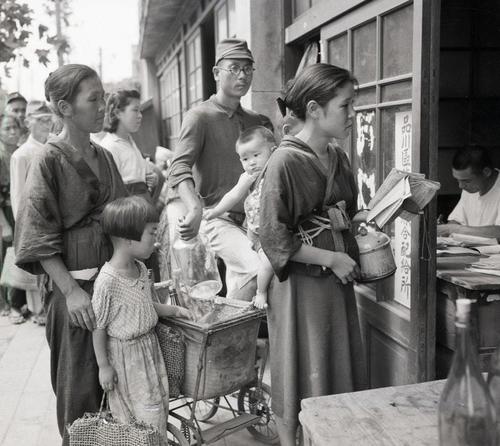
Desperate Japanese citizens queuing up for food rations
2. Art, gold and jewelry
Gold and jewelry is portable, liquid and easily protected compared to building structures. Throughout the early 1940s it remained easy to transfer gold and jewelry to Switzerland from almost anywhere in Europe. So jewelry and gold played a crucial role in preserving wealth for any individual that stayed within an occupied country.
The difficulty was to hide jewelry from thieves and occupying forces.
You could hide jewelry in deposit boxes. But as happened in France in the early 1940s, French banks had to report to the Germans the contents of all safe deposit boxes. The contents of those safe deposit boxes were then transferred to Germany.
Another option was to stash jewelry at home. The downside of keeping jewelry inside your home is that bombing campaigns tend to lead to an increase in crime, as experienced in Britain throughout the 1940s. As Barton Biggs says “war unravels the bonds of civil society”. A rich old lady he knew “slept with [her] jewelry instead of her husband for four years” out of fear it would be stolen from her. Anything ostentatious was stolen.
In Italy, some families banded together, moved their prized possessions to defensible villas in the hills and stood ready to fight for their lives, all while desperate groups wandered the countryside searching for loot. You had to protect your property with your life. In countries occupied by Germany, informants told German officers where jewelry was stashed and large estates were often ransacked by them. Con artists flourished, often promising to hold jewelry safe on behalf of others, then running off to a far-away land never to be seen again.
A safety box outside the country would have kept jewelry safe. But you had to keep them secret. When your neighbours’ children are starving, they will do anything – including reporting you to occupying forces.
Jewelry is more liquid than property, so it could readily be swapped for necessities such as food and medicine. At a discount, of course. In an occupied country filled with informers and treachery, you had to watch your back when transacting in jewelry. Or accept a large discount from better-known black market dealers.
In Soviet-occupied countries, Soviet soldiers often fancied watches and jewelry and had no qualms murdering to get them. The Red Army was also used by high Soviet officials to help plunder for them. Clothes, cars, fine china, jewelry, art and grand pianos were shipped back to Russia. So jewelry did not preserve wealth effectively in countries occupied by Soviet forces.
Art performed poorly as a wealth preserver during WWII. It is vulnerable to destruction by fire, can easily be damaged, quickly plundered and is difficult to hide. But if you had capital to buy them during the war, you would have made a fortune. Keynes famously went on a mission to Paris in the spring of 1940 to buy, to the sound of howitzers, two Cézannes and two Delacroix that subsequently appreciated 40x in the next four decades.
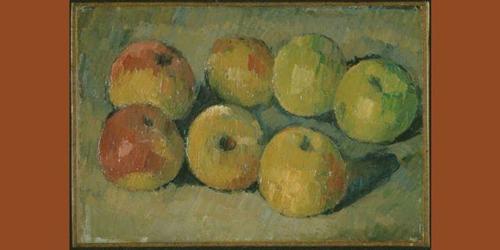
The Cézanne painting purchase by Keynes in the spring of 1940
3. Overseas assets
Overseas assets also helped preserve wealth. Especially if kept in safe jurisdictions such as Switzerland. That was especially the case for individuals in occupied countries, whose domestic wealth was often confiscated by authorities. The key was to keep bank accounts in overseas countries secret – from tax authorities and even from friends & family.
That said, getting money out was not always easy as exchange controls and taxes often ate up a large portion of the capital. For example, by the end of the 1930s, Jewish business owners in Germany had to accept large discounts if they wanted to sell their businesses – often at 50% of fair value. Even homes had to be sold at discounts. And if they wanted to bring money out of the country, they had to pay exorbitant foreign exchange taxes of up to 90%.
Even overseas assets were expropriated in some cases. In the early 1940s, the UK the government became short of US Dollar for purchases of war materials. So the Chancellor of the Exchequer decreed that British citizens who owned US stocks had to report them to the Bank of England, and they were then sold to fund munitions purchases. The holders of those US stocks received a credit in pounds for the proceeds of the sales. Keeping your foreign assets secret remained key in avoiding confiscation.
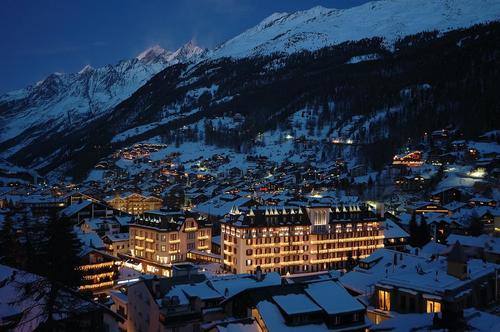
A private bank in Zermatt, Switzerland with underground bunkers and storage facilities for gold
4. Domestic stocks
The experience of WWII is that stocks generally did preserve wealth. But stocks had substantially higher returns if their home country was on the winning side. Losing the war and becoming occupied destroyed a country’s long-term return in equities.
It wasn’t a smooth ride. The US stock market was sleepy during the war and stock prices fell to very low levels. A seat on the New York Stock Exchange cost only $17,000 in 1942, roughly 97% lower than the peak of $625,000 in 1929. And P/E ratios stayed low throughout the war. In 1942, the median P/E ratio for 600 representative stocks was only 5.3x. Only 10% of stocks traded at a P/E multiple over 10x trailing earnings.
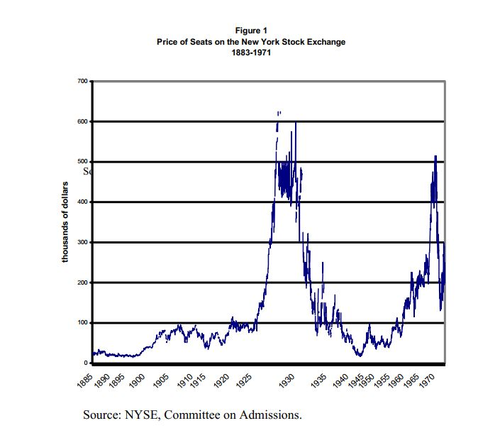
Stocks reflected the success each country’s military advances or setbacks. The British stock market bottomed right before the Battle of Britain in 1940, when it successfully staved off a German invasion. The German market peaked when German troops reached Moscow in 1941, just prior to the setback in Stalingrad. The bottom for the US market in May 1942 coincided with the Battle of Midway, when US forces dealt a decisive blow to the Japanese Navy.
So if you own stock in a particular country, you better have conviction that it can win a war and avoid becoming occupied territory.
War spending via budget deficits was generally positive for the domestic stock market in nominal terms. From 1932 until the 1937-38 high – a period of record deficit spending – Germany was the best stock market in the world. After a brief respite, the market continued to rally all the way to the Battle of Stalingrad. This period was characterized by booming military production and eventually soaring profits from low-cost forced labour from France, Poland and Holland. Eventually however, budget deficits led to a drain of foreign currency reserves that made it difficult to keep up elevated spending levels. Stock prices stopped rising.
After Germany’s defeat at the Battle of Stalingrad, the Nazi government finally imposed controls on stock prices for the remainder of WWII to conceal the damage. No German could legally sell shares without first offering them to the Reichsbank, which had the option of buying them at 1941 prices in exchange for rapidly depreciating government bonds. After the war, the German stock market absolutely collapsed as you can see from the below chart.
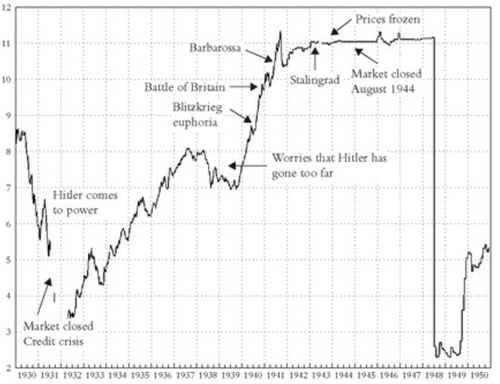
Germany’s CDAX index
Holding stocks through the war required a nerve of steel. At market bottoms in the US, the UK and elsewhere, newspaper commentary was consistently negative and pessimistic. In every allied country, the market bottomed during major negative events, such as the Dunkirk evacuation and the fall of France to the Nazis.
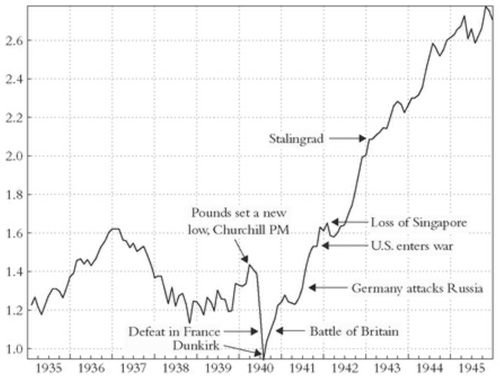
UK Financial Times, 30 Industrials index
Likewise, the US stock market bottomed during the Battle of Midway, when newspaper commentary was largely negative. By the time of German surrender at Stalingrad, the US market had already risen well over 50%. So owners of US stocks had to stomach holding these stocks in the face of negative – or even catastrophic – news.

US Dow Jones Index
In Japan, newspapers and radio broadcast only good news about the course of the war. But in elite tea houses in Tokyo, information about the progress of the war was passed around to intelligent observers. Hence, the stock market correctly discounted Japan’s prospects of a victory in the war. The market fell gradually as the war progressed and collapsed completely in 1945 as Japan was defeated in a final blow. In real terms, Japan’s stock prices fell roughly 26% per year from 1940 to 1949. In nominal terms stocks did actually rise despite the spectacular defeat in 1945.
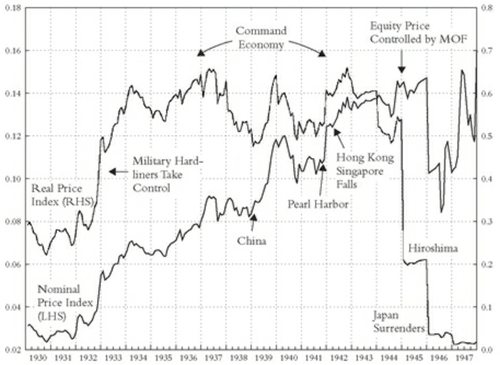
Japan stock market price index (real + nominal), as estimated by Citigroup
Stock markets in occupied territories performed poorly during WWII. Inflation was almost twice as high in the loser countries than in the countries that managed to avoid the war. The countries at risk of becoming occupied were primarily those in close proximity to Germany, Soviet Union, Italy and Japan: European countries and Southeast Asia.
During WWII, a number of stock markets had “permanent breaks” with the market closing and never restarting again. That happened in Hungary, Czechoslovakia, Romania, Poland and Finland when they were taken over by the Soviet Union. Communism is clearly the greatest enemy of wealth preservation.
Private wealth in Singapore and Hong Kong also suffered immensely in 1942-45 when they were taken over by Japan.
Stock markets in countries that were occupied by the Germans also suffered, though some emerged unscathed: including Austria, Denmark and Holland. Many families in Holland were able to keep their homes, land and small enterprises during the entire occupation. If you were Jewish or an enemy of the state, your property was seized just like in Germany.
France was treated poorly by their German occupiers. French were deemed not Aryan enough to be treated as equals. French patents, equipment and skilled workers were “temporarily” transferred to Germany, gutting French industry from intellectual property. Other French companies prospered mightily from military contracts. French inflation was 20% per year during the war and rose to 60% in the years following the war, completely destroying the economy. French stocks helped preserve wealth somewhat, but in real terms the stock market fell drastically throughout the 1940s.
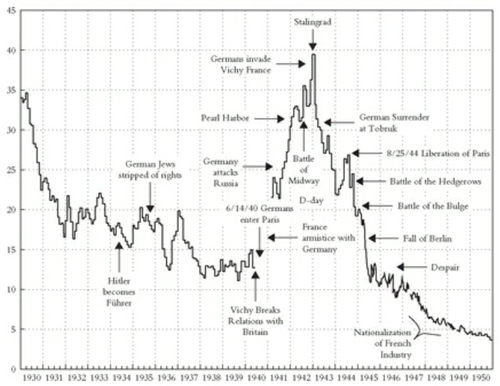
France SBF-250 index, adjusted for inflation
5. Property
Physical property is a dangerous thing to posses in wartime. It often gets stolen, bombed, destroyed or expropriated.
In Nazi Germany, unless you were Jewish, property rights were generally respected. But in occupied countries of Eastern Europe, prime real estate were almost always expropriated. High-profile mansion and real estate were often used by the Wehrmacht or confiscated to become country estates for top German officers. In Hong Kong, the Chinese found that all their money and home on Victoria Peak were worth very little when the Japanese occupied the city in 1942.
Hyperinflation caused a particular problem, as interest rates rose to radical levels. Landowners who had paid off their mortgages on the other hand survived, and business owners who had repaid their loans became unencumbered owners of real property.
If you left property, getting it back after the war proved to be difficult in many cases. But if local property records remained intact, land often preserved wealth.
UK and US real estate lost value during the war, with prices falling to very low levels. Rents in Wall Street office buildings were as low as $1/sqft. A seller of a New York hotel had difficulties finding buyers, even at one time annual earnings.
A working farm often protected both wealth and your life, providing safety and food. There are number of anecdotes of affluent French families that shuttered their Paris houses in 1940 and retreated with their most precious possessions to family farms in the deep countryside, living in relative comfort through the war.
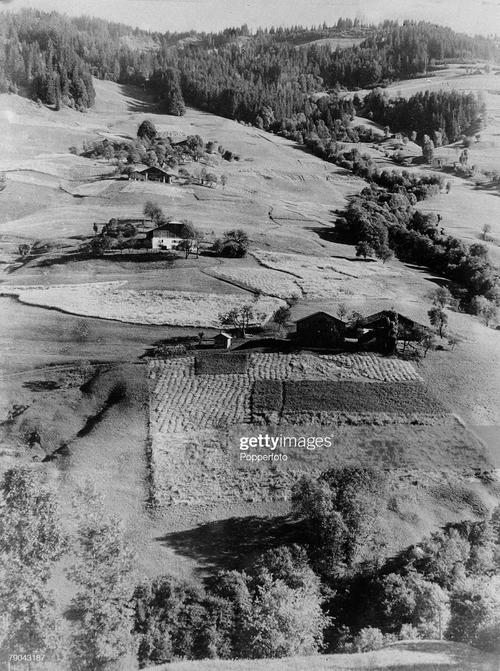
Remote farmland in the French alps during World War II
6. Fixed income securities
Budget deficits and war spending spells disaster for the ownership of government bonds. Even in the loser countries, stocks tends to beat bonds, and bonds tend to beat short-term bills and demand deposits.
Due to Japan’s deficit spending on war materials, prices rose 3,280% from 1930 to 1949. That caused a carnage in Japanese government bonds, which lost roughly 17% per year from 1940 to 1949.
German government bonds saw their purchasing power erode roughly 21% per year in the 1940s, or a loss of 90% during the 1940s.
In Italy, owners of fixed income securities were impoverished by the war. Government bonds lost 27% per year in real terms in the 1940s and government bills lost 30% per year.
Other European countries did not fare much better, as you can see from the below table:

Total real returns of a number of European countries
Conclusion
The best in-country stores of wealth are non-ostentatious property, such as remote farmland or vineyards. Just make sure the mortgages are paid off. Jewelry and gold are crucial since they can be readily exchanged for daily necessities.
The best out-of-country stores of wealth are equities, jewelry and land. They should be stored in safe jurisdictions, protected by geography, rule of law and a strong national defense. The United States, New Zealand, the United Kingdom and Switzerland come to mind. Don’t be tempted to sell just because news go from bad to worse. And maintain a well-diversified portfolio of stocks.
The biggest lesson of all might be to avoid fixed income instruments, including government bonds and demand deposits. Especially in countries at risk of becoming occupied by communist forces.
Those are the key investing lessons from World War II.